- Stand-out styling
- Design-forward cabin
- Plenty of space
- Available high-tech features
- Turbo powertrain is a miss
- Advanced safety features are optional
The hamsters from the last-gen Kia Soul have run out of town. Why? The new Soul scared them away. Those cute rodents were aimed at getting younger drivers into the boxy vehicle.
Now, things are different. Everyone knows about the Soul, but they’re familiar with the cutesy version. The all-new 2020 Kia Soul is here to show off a new side of the machine — a sharper, more aggressive edge to prove that going against the grain is a good thing.
Hatchback? SUV? CUV? One could technically make the argument that the Soul is all of these. The classification isn’t important, because you’re getting the best of all worlds. Its subcompact size means pricing starts at an affordable $17,490 for the base LX trim. Move up to the GT-Line Turbo, which is the vehicle we tested for a week, and you’re looking at a starting price of $27,490. That’s still affordable by today’s standards.
It’s apparent that American consumers are sticking to their crossovers. But unlike CUVs that stick firmly to a recipe, the Soul, especially in the GT-Line trim, breaks the mold to give buyers a look at what fun, cheap, and versatile looks like. From this angle, it’s great, but not perfect.
Interior and exterior design
The old Soul was a box on wheels, and so is the new one. Looking at the Soul can transport you back to elementary school, when you had to deal with those horrible square milk cartons. Just add in four wheels.
While the overall silhouette hasn’t changed, nearly everything else has. The headlights have moved down the front fascia, while slim daytime running lights are now connected through a paper-thin grille. Around the back, the taillights have a hockey-stick shape that connects at the top.
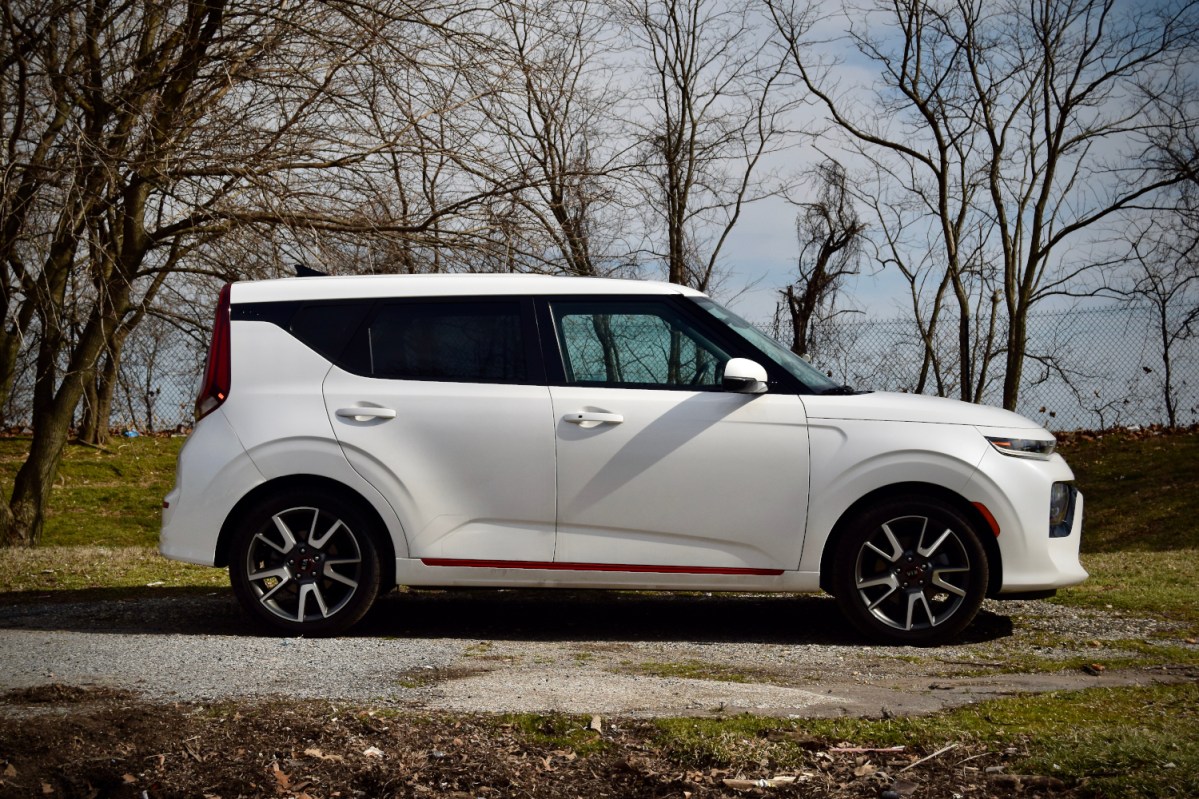
The 2020 Soul has a more muscular aesthetic that sharply contrasts with the adorable look from last gen’s model. You can also spec the Soul with a two-tone color scheme for extra character.
Go for either the X-Line, or one of the GT-Line trims, and your subcompact CUV comes with a unique body kit. The X-Line does an impression of an off-road CUV with special 18-inch wheels, roof rails, and body cladding. The two GT-Line trims go for a sporty design, with the GT-Line Turbo getting distinct wheels, red badges, black trim pieces, and center-exit exhaust.
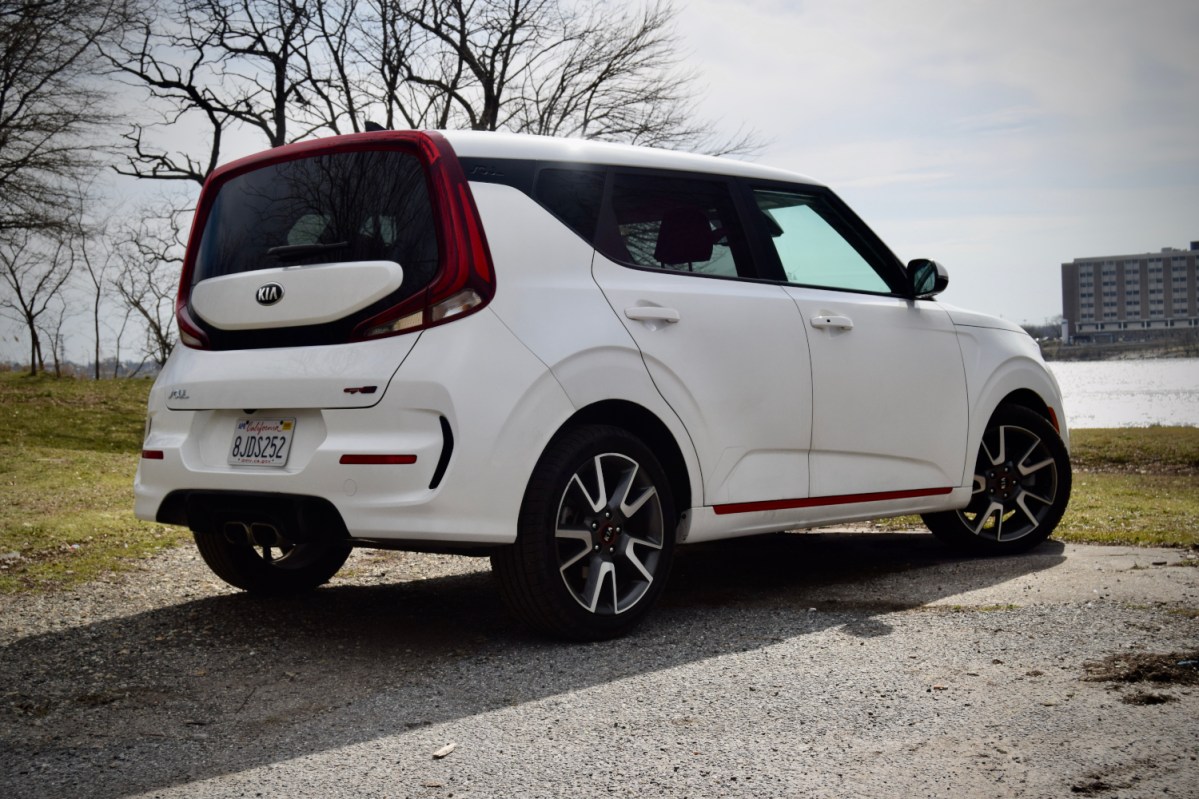
People may be split on the Soul’s exterior design, but this box brings the heat inside. Legroom and headroom are abundantly available in both rows, with even the tallest of passengers forgetting that they’ve been relegated to the back. Utility is just as impressive, as the Soul can carry 24.2 cubic feet of cargo behind the rear seats, and has capacity for a total of 62.1 cubic feet of cargo. Those figures make the Soul one of the more spacious options in the segment, beating the Hyundai Kona, Nissan Kicks, and Honda HR-V.
There’s still an element of fun that exists alongside all of this utility. From the triangular vents to the space-like trim that surrounds the door handle and speakers, the Soul’s cabin is snazzy, yet functional. Our Soul GT-Line Turbo came with mood lighting that matches the rhythm of the music in different colors or themes like “Midnight City,” “Café,” and “Romance.”
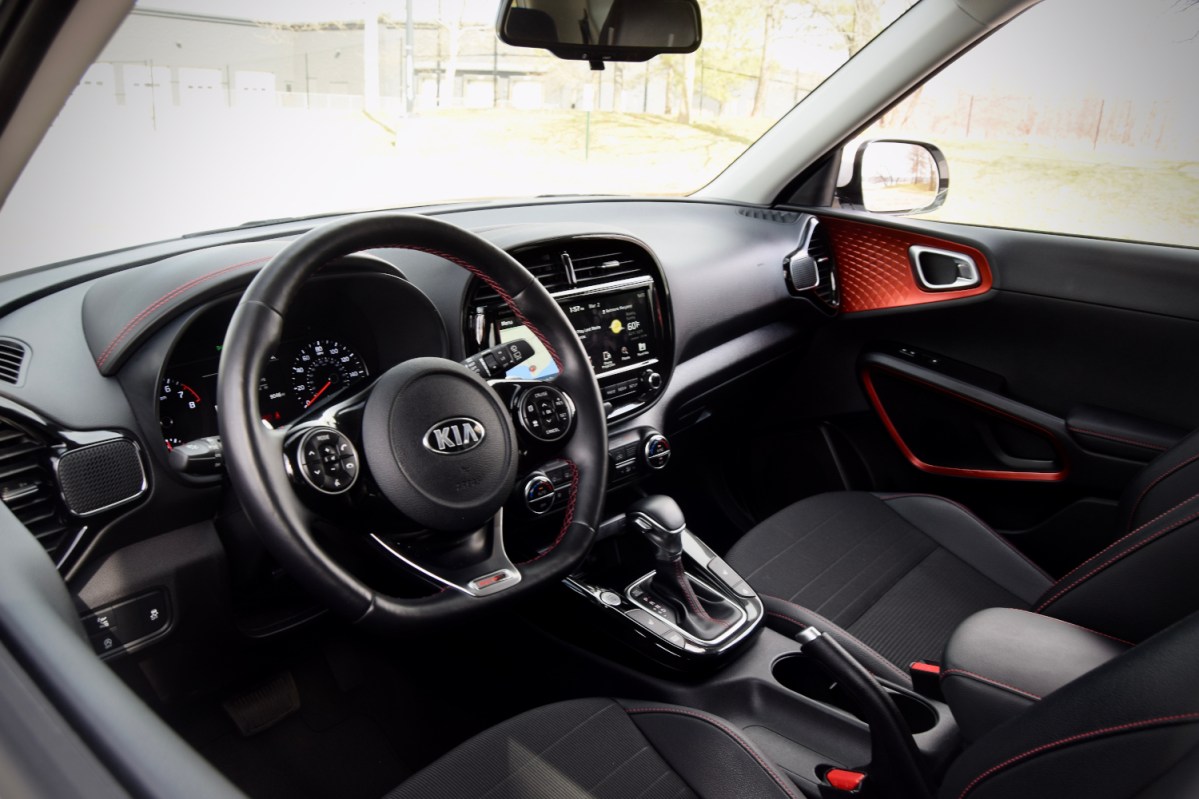
While spacious, the Soul is an affordable way to get around, so it has its fair share of hard plastics and rough materials scattered throughout. Still, none of it feels cheap. For a car that costs under $29,000, the Soul GT-Line Turbo feels and looks well-designed. The leather and cloth seats are sturdy yet comfortable, with the heated seats warming up your backside quicker than a hot tub.
Tire and wind noise can disturb the peace at highway speeds, and the seats feel rather high at their lowest position. Of course, that may not be a downside for consumers yearning for that CUV feel.
Tech features
Kia does make you reach far into your pockets to grab the best tech features, but this economy box comes with plenty of tech standard. The majority of trims have a 7-inch touchscreen that includes both Apple CarPlay and Android Auto. That’s nothing out of the ordinary, though, as nearly every competitor can match that.
Where the Soul really flexes its muscles is when you start to get higher up the food chain. EX and GT-Line Turbo models come with a massive 10.25-inch touchscreen and Kia’s slick UVO infotainment system. That’s one of the largest screens you’ll find in the segment, easily beating the available 8-inch screen in the Hyundai Kona, and the 7-inch touchscreens in the Nissan Kicks and Honda HR-V. As an added benefit, you get wireless charging with the larger screen.
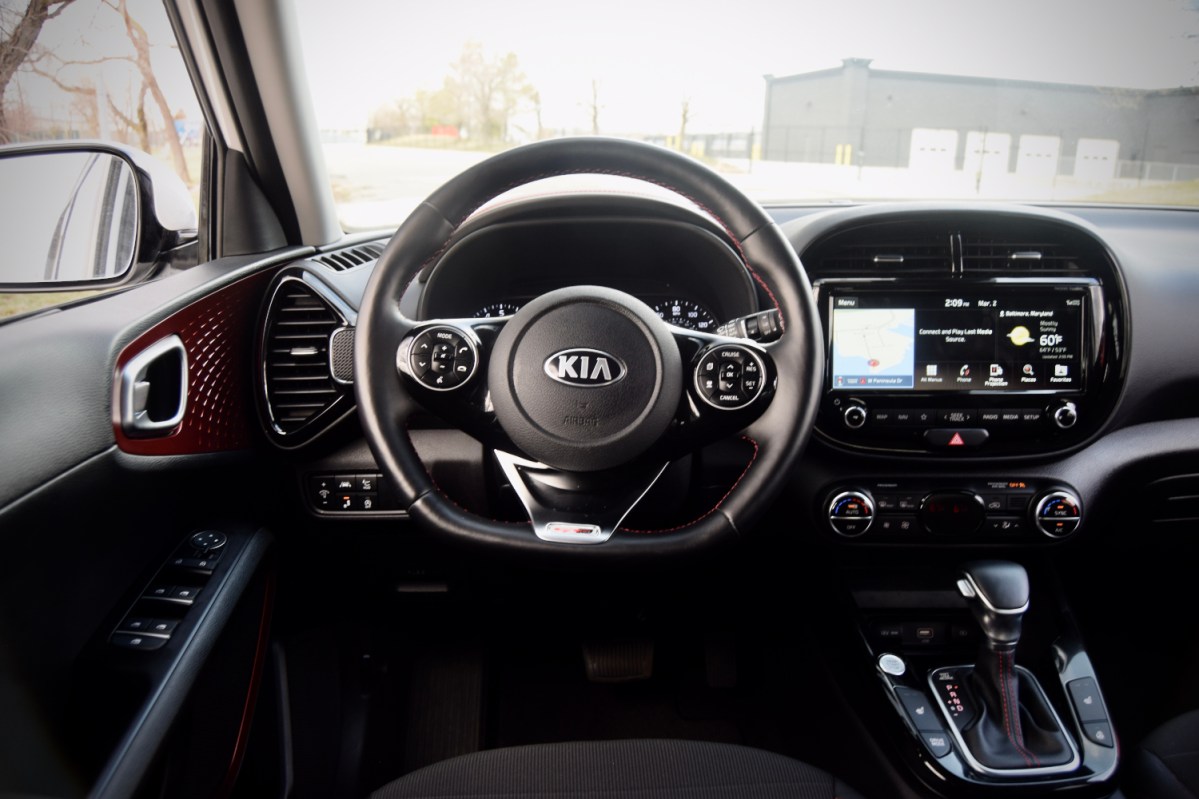
Having spent time with both systems, this is an easy decision. Get the larger 10.25-inch screen. The standard 7-inch unit is basic – iPhone 6 levels of basic. The 10.25-inch screen with the UVO system is a gem, featuring clear, crisp images in an intuitive layout. The extra-wide length puts three really helpful things – navigation, audio, and weather – front and center. If one of those doesn’t sound important, there’s plenty of customization to let you prioritize as you see fit.
The Soul’s list of safety features follows the same trajectory as its infotainment systems. All you get with the base trim is a rearview camera. The higher up the ladder you climb, the more you get, with the GT-Line Turbo being packed with nearly everything under the sun, including blind-spot monitoring, pedestrian detection, and lane-keep assist. A retractable head-up display is also included in the safety cocktail.
For the most part, the driver-assist features all work as they should — except for the lane-keep assist system. That sucker will yank the wheel out of your hands to stop you from drifting into another lane. Some nitpickers may think the head-up display screen looks cheap, too. That may be true, but it works, and it’s a feature you won’t find in the Honda HR-V and Nissan Kicks.
Driving experience
There are two available powertrains for the Soul. Five out of the six trims come with a 2.0-liter four-cylinder engine that makes 147 horsepower and 132 pound-feet of torque. The engine is paired to a continuously variable transmission that Kia calls an “intelligent variable transmission,” or IVT.
Only the GT-Line Turbo has a different mill. That trim comes with a turbocharged 1.6-liter four-cylinder engine that’s good for 201 hp and 195 lb.-ft. of torque. The engine also comes with a unique transmission in the form of a seven-speed dual-clutch.
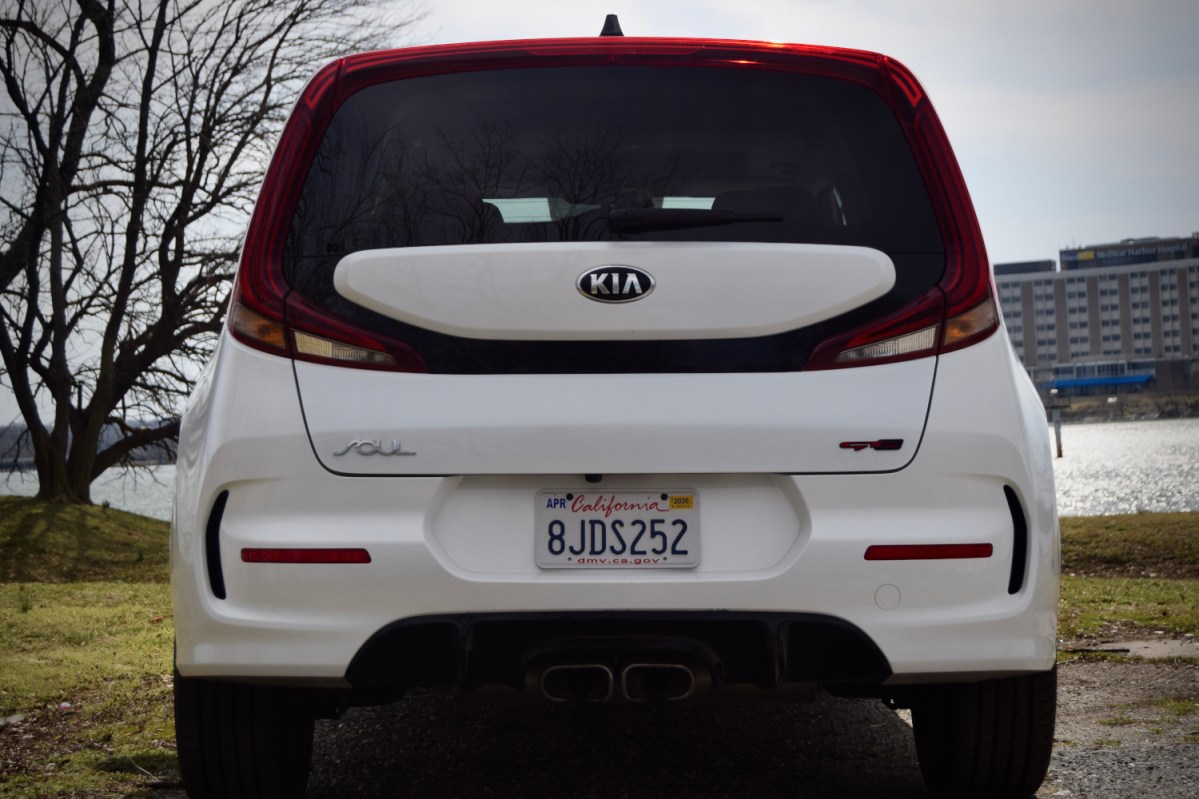
With 54 extra horses and a dual-clutch gearbox, you’d expect the GT-Line Turbo to be the performance-forward trim. And you would be correct. But the powertrain has some serious flaws that highlight just how nonathletic the subcompact CUV really is.
The peppy motor doesn’t lack grunt, but the way it puts down the power in one massive gulp instead of a smooth set of sips is jarring The issue is exacerbated because of the dual-clutch transmission, which is slow to shift, clunky at low speeds, and quick to provide a surge in power unexpectedly. Stabbing the throttle from a standstill doesn’t result in immediate power, making parking a tricky situation.
The expensive GT-Line Turbo trim is an easy pass.
In addition to the engine, the GT-Line Turbo comes with a firmer suspension. The ride is stiff, but the Soul doesn’t feel limber around corners, as the boxy design limits true performance potential. Around corners, the Soul exhibits body roll befitting a subcompact CUV, and the GT-Line Turbo’s Goodyear Eagle Touring tires don’t inspire confidence.
Ironically, the Soul’s front-wheel-drive-only layout isn’t a dealbreaker. Other subcompacts like the Nissan Kicks and the Toyota C-HR are front-wheel drive only, too. You’re still getting 6.7 inches of ground clearance, which is a decent amount to tackle snow. If you want any kind of real off-roading capability, though, you’ll have to look toward the Jeep Renegade.
With the powertrain’s issues and the extra bumpy ride that doesn’t translate to real sporting potential, the expensive GT-Line Turbo trim is an easy pass.
Gas mileage and safety
The Environmental Protection Agency rates the 2020 Kia Soul at up to 31 mpg combined (29 mpg city, 35 mpg highway) when equipped with the 2.0-liter four-cylinder engine and the CVT. If you go with the sportier GT-Line Turbo trim with the turbocharged 1.6-liter four-cylinder and seven-speed dual-clutch transmission, you’re looking at 29 mpg combined (27 mpg city, 32 mpg highway).
Those aren’t bad figures for the subcompact segment, but they do put the Soul behind the Nissan Kicks, which is rated at 33 mpg combined, and the new Hyundai Venue that’s rated at 32 mpg combined. But the Soul is slightly more efficient than the Honda HR-V and the Hyundai Kona, which both have combined fuel economy ratings of 30 mpg.
With the Soul being all-new for the 2020 model year, it’s tough to say how reliable the vehicle will be down the road. The subcompact CUV does come with one of the lengthiest warranties on the market: A 10-year, 100,000-mile powertrain warranty and a five-year, 60,000-mile limited warranty. That’s better than what you’ll find with cars from Nissan or Honda.
Being a new vehicle, the Soul hasn’t been crash-tested by the National Highway Traffic Safety Administration (NHTSA) yet. In the Insurance Institute for Highway Safety’s (IIHS) tests, the Soul did well enough to be named a Top Safety Pick.
How DT would configure this car
Because of the issues with the powertrain and ride, we recommend skipping the GT-Line Turbo trim. With that said, we like the EX trim the most. It has the same 10.25-inch touchscreen, UVO infotainment system, and wireless charger as the top-of-the-line model, but comes with the more efficient powertrain.
The 2020 Soul has a more muscular aesthetic that sharply contrasts with the adorable look of last gen’s model.
If you’d like a two-tone paint scheme, it’s part of the $1,500 EX Designer Collection Package.
Our take
Despite testing what is arguably the worst option in the lineup, the 2020 Kia Soul is a great CUV. Its looks won’t be to everyone’s tastes, but it stands out in a segment that’s filled with boring options. It’s practical, too, with one of the largest cargo areas, loads of tech features, and an efficient powertrain. This is all wrapped in one of the snazziest designs and backed by one of the lengthiest warranties, too.
If you’re looking for anything close to decent off-road capability, you’ll have to go with the Jeep Renegade. For those wanting a vehicle with a design that doesn’t stand out as much, you’ll want to look at the Nissan Kicks, Hyundai Kona, or Honda HR-V.
The Kicks doesn’t have all-wheel drive as an option, but the other two do. Neither the Kicks nor the HR-V come with Apple CarPlay or Android Auto as standard, but both come with safety suites in the middle of their respective lineups instead of random features that are sporadically spread around. As usual, Kia’s priced the Soul competitively, and between these competitors, it’s the most affordable option of the bunch.
With so many options to choose from in the subcompact segment, there’s bound to be one option that does something better than the Soul. But as a complete package, it’s a well-rounded CUV that manages to do a lot well at a low price, making it one of the better options on the market.
Should you get one?
Yes. The Soul is a great value with funky, functional design. Just stay away from the GT-Line.





